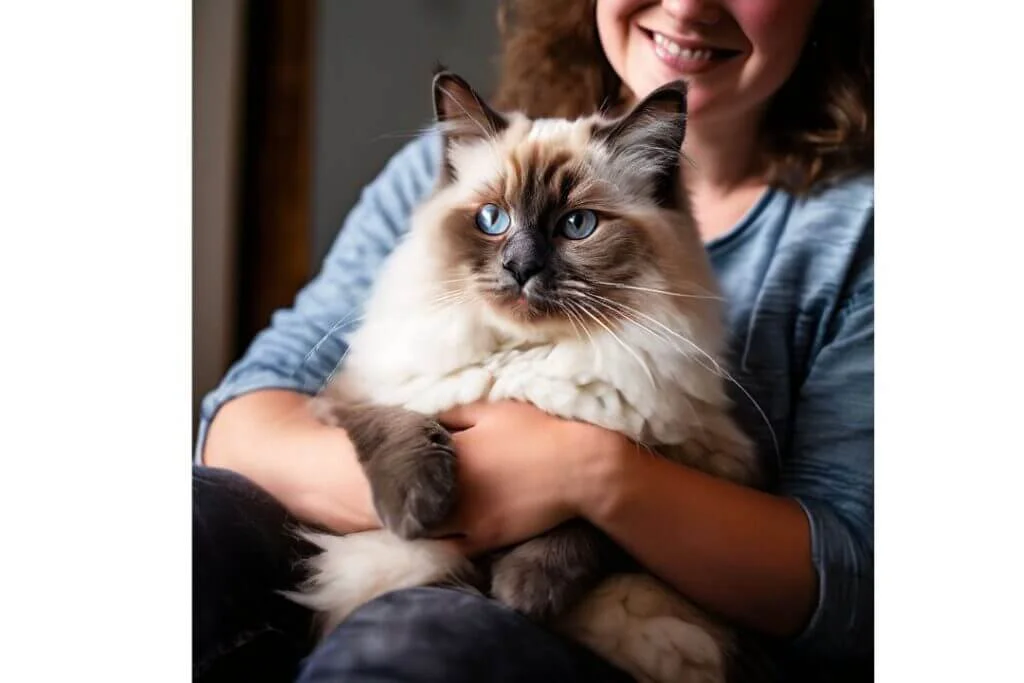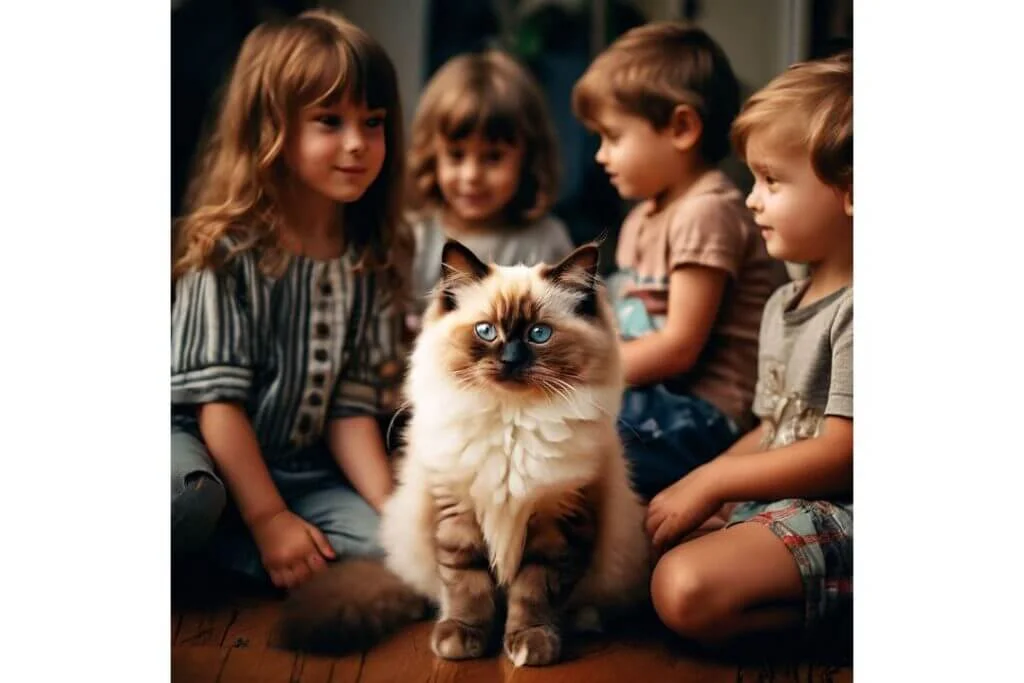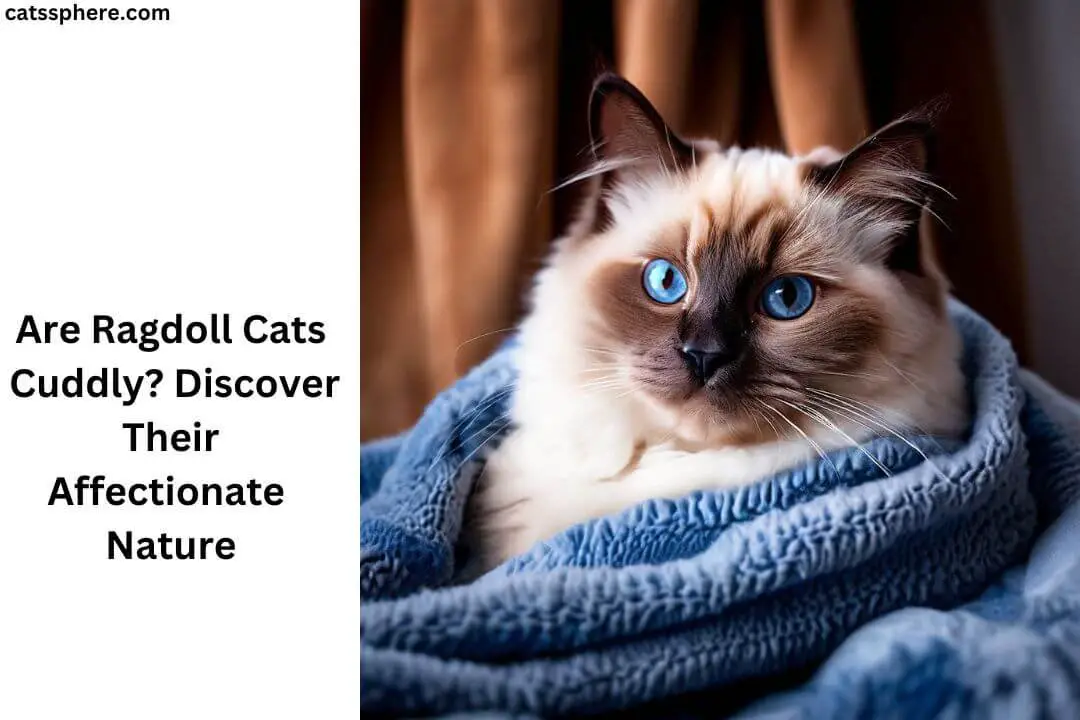Introduction
When it comes to choosing the perfect pet, understanding the nuances of different cat breeds is crucial. Each breed has its unique traits, and knowing these can help you find a furry companion that matches your lifestyle. One breed that has garnered significant attention for its affectionate nature is the Ragdoll cat. But are Ragdoll cats cuddly, or is this just a myth? Let’s dive into the world of Ragdoll cats to find out.
What Are Ragdoll Cats?
Origin and History
Ragdoll cats originated in the 1960s in California, thanks to a breeder named Ann Baker. She aimed to create a breed that was not only beautiful but also exceptionally gentle and docile. The Ragdoll’s name comes from their tendency to go limp when picked up, much like a ragdoll toy.
Physical Characteristics
Ragdolls are known for their striking blue eyes, silky fur, and large size. They have semi-long hair that is soft to the touch, and their coat comes in various colors and patterns. These cats are muscular yet gentle in appearance, with a plush, luxurious coat that adds to their appeal.
Temperament and Personality
The temperament of Ragdoll cats is one of their most notable features. They are often described as friendly, calm, and sociable. Unlike many other cats, Ragdolls tend to enjoy being held and are known to follow their owners around the house, seeking companionship.
Why Are Ragdoll Cats Known as Cuddly Cats?

The “Ragdoll” Name: A Clue to Their Nature
The name “Ragdoll” itself is indicative of their cuddly nature. These cats are known for their tendency to relax and go limp when picked up, making them feel like a soft, plush toy in your arms.
Key Traits That Make Them Cuddly
Several traits contribute to the Ragdoll’s cuddly reputation:
- Gentle Disposition: Ragdolls are known for their laid-back and gentle nature.
- Affectionate Behavior: They love to be close to their humans, often curling up on laps or next to their owners.
- Sociable Nature: These cats are very social and enjoy interacting with people and other pets.
Comparison with Other Breeds
Compared to other cat breeds, Ragdolls stand out for their unique combination of size, temperament, and affectionate behavior. While breeds like the Siamese and Persian also have loyal followings, Ragdolls are particularly noted for their dog-like devotion and willingness to be handled.
Understanding Ragdoll Cat Behavior
Social Nature
Ragdolls thrive on social interaction. They enjoy being part of the family and are known to greet their owners at the door, follow them around the house, and participate in daily activities.
Affectionate Interactions
These cats are incredibly affectionate. They often seek out physical contact, whether it’s snuggling in your lap, lying beside you, or gently nudging you for attention. Ragdolls are also known to enjoy being cradled like babies, showcasing their trust and affection.
Adaptability to Family Life
Ragdolls adapt well to various household environments, making them great companions for families, singles, and seniors alike. Their calm demeanor means they are less likely to be startled by loud noises or sudden changes, making them ideal for busy households.
The Science Behind Cat Cuddliness
Genetic Factors
Genetics play a significant role in the temperament of Ragdoll cats. Selective breeding has emphasized traits like gentleness and sociability, making these cats naturally inclined to be more affectionate and cuddly.
Environmental Influences
While genetics lay the foundation, the environment also shapes a Ragdoll’s behavior. A nurturing and loving home environment will encourage their natural cuddly tendencies. Socialization from a young age is key to developing a friendly and affectionate adult cat.
Human-Cat Bonding
The bond between humans and Ragdolls is often strong due to their affectionate nature. These cats tend to form deep attachments to their owners, enjoying both quiet companionship and playful interactions. This bond further reinforces their cuddly behavior.
Training and Socialization
Importance of Early Socialization
Early socialization is crucial for Ragdolls to develop into well-adjusted, affectionate adults. Exposure to different people, pets, and environments from a young age helps them become more adaptable and sociable.
Tips for Encouraging Cuddly Behavior
To encourage cuddly behavior in your Ragdoll:
- Spend Quality Time: Regularly spend time interacting with your cat through play, petting, and talking.
- Positive Reinforcement: Reward affectionate behavior with treats and praise.
- Gentle Handling: Always handle your Ragdoll gently to ensure they associate human contact with comfort and safety.
Handling and Play

Ragdolls enjoy being handled, but it’s important to do so correctly to avoid causing them stress or discomfort. Support their body fully when picking them up and engage in gentle play to keep them happy and healthy.
Living with a Ragdoll Cat
Creating a Comfortable Environment
Providing a comfortable living environment is essential for a happy Ragdoll. Ensure they have cozy sleeping areas, scratching posts, and safe spaces to retreat to when they need a break.
Daily Care and Grooming
Ragdolls require regular grooming to keep their coat in top condition. Brush their fur several times a week to prevent tangles and mats, and check their ears, teeth, and claws regularly.
Health Considerations
Like all breeds, Ragdolls are prone to certain health issues, such as hypertrophic cardiomyopathy (HCM) and kidney disease. Regular vet check-ups are essential to catch any potential health problems early.
Ragdoll Cats and Children

Safety Tips
Ragdolls are generally great with children due to their gentle nature. However, it’s important to teach kids how to interact with cats respectfully to ensure both the cat and the child are safe.
Benefits for Children
Having a Ragdoll cat can be beneficial for children, teaching them responsibility and empathy. The cat’s affectionate nature can also provide emotional comfort and companionship.
Supervision and Interaction
Always supervise interactions between young children and Ragdoll cats to ensure the play remains gentle and safe. Encourage positive and respectful behavior towards the cat.
Ragdoll Cats and Other Pets
Compatibility with Dogs
Ragdolls are often compatible with dogs, especially if introduced properly. Their laid-back nature means they can get along well with canine companions who are also gentle and friendly.
Interaction with Other Cats

Ragdolls generally get along well with other cats like siberian, himalayan etc ticularly if they are introduced gradually and carefully. Their social nature means they enjoy the company of other feline friends.
Managing a Multi-Pet Household
In a multi-pet household, it’s important to ensure all animals have their own space and resources to avoid conflict. Monitor interactions and provide plenty of attention to each pet.
Common Misconceptions About Ragdoll Cats
Do They Require Constant Attention?
While Ragdolls enjoy human interaction, they do not require constant attention. They are capable of entertaining themselves but will appreciate regular companionship.
Are They Always Laid-Back?
Although Ragdolls are known for their calm demeanor, they also have playful and energetic moments. Each cat has its own personality, so some may be more active than others.
Debunking Myths
There are several myths about Ragdolls, such as the belief that they don’t feel pain or are completely inactive. It’s important to understand that these are misconceptions and that Ragdolls, like all cats, have individual needs and behaviors.
Caring for a Cuddly Ragdoll
Proper Diet
A balanced diet is crucial for maintaining a Ragdoll’s health and energy levels. Consult with your vet to choose the best food for your cat’s age, weight, and health needs.
Regular Vet Visits
Regular vet visits are essential to monitor your Ragdoll’s health and catch any potential issues early. Vaccinations, dental care, and routine check-ups should be part of their care routine.
Mental and Physical Stimulation
Provide plenty of toys and opportunities for play to keep your Ragdoll mentally and physically stimulated. Puzzle feeders, interactive toys, and regular play sessions can help prevent boredom and keep them happy.
Adopting a Ragdoll Cat
Choosing a Reputable Breeder
If you decide to buy a Ragdoll, choose a reputable breeder who prioritizes health and temperament. Ask for health clearances and visit the breeding facility to ensure the cats are well cared for.
Adoption vs. Buying
Adopting a Ragdoll from a shelter or rescue can be a rewarding experience. Many Ragdolls in need of homes are waiting for loving families, and adopting can save a life.
Preparing Your Home
Before bringing a Ragdoll home, prepare your space by setting up a cozy bed, litter box, scratching posts, and plenty of toys. Ensure your home is safe and cat-friendly.
How Are Ragdoll Cats with Dogs? Understanding Their Unique Bond
Can Ragdoll Cats Go Outside? Is It Safe and Advisable
Potential Challenges
Health Issues to Watch For
Ragdolls can be prone to certain health issues, such as heart disease and urinary tract problems. Regular vet care and a healthy lifestyle can help manage these risks.
Grooming Challenges
Their long, silky coat requires regular grooming to prevent matting. Be prepared to invest time in brushing your Ragdoll several times a week.
Behavioral Concerns
While generally easygoing, some Ragdolls may develop behavioral issues like excessive meowing or scratching. Consistent training and providing a stimulating environment can help mitigate these problems.
Personal Stories and Testimonials
Experiences from Ragdoll Owners
Many Ragdoll owners share stories of their cats’ affectionate and gentle nature. Testimonials often highlight their love for cuddling, following their owners, and being the perfect lap cat.
Quotes and Anecdotes
One owner, Sarah, says, “My Ragdoll, Luna, is the sweetest cat I’ve ever had. She loves to snuggle and always greets me at the door with a purr.” Another owner, John, shares, “Max, my Ragdoll, is like a little shadow. He follows me everywhere and loves to cuddle up on the couch.”
What Makes Them Special?
Ragdolls are special because of their unique combination of beauty, gentleness, and affection. Their ability to bond deeply with their owners and their adaptable nature make them ideal pets for many households.
Conclusion: Are Ragdoll Cats Cuddly?

In conclusion, Ragdoll cats are indeed cuddly, living up to their reputation as one of the most affectionate cat breeds. Their gentle disposition, love for human interaction, and adaptable nature make them wonderful companions. Whether you’re looking for a lap cat to snuggle with or a gentle friend for your family, a Ragdoll cat can be a perfect choice. Their unique combination of traits ensures that they will bring joy and comfort to any home they join.
FAQs
Are Ragdoll cats suitable for apartment living?
Yes, Ragdoll cats can adapt well to apartment living as long as they have enough stimulation and space to move around. Their calm nature makes them well-suited for smaller living spaces.
Do Ragdoll cats need a lot of grooming?
Yes, Ragdolls require regular grooming due to their semi-long fur. Brushing them several times a week helps prevent matting and keeps their coat healthy.
How do Ragdoll cats behave around strangers?
Ragdolls are generally friendly and sociable, even with strangers. They tend to be curious and may approach new people with a gentle and affectionate demeanor.
What is the lifespan of a Ragdoll cat?
Ragdoll cats typically have a lifespan of 12 to 15 years, although with proper care, some can live even longer. Regular vet check-ups and a healthy lifestyle contribute to their longevity.
Are Ragdoll cats hypoallergenic?
No, Ragdoll cats are not hypoallergenic. They produce dander, which can trigger allergies in sensitive individuals. However, their grooming needs and regular cleaning can help minimize allergens.

